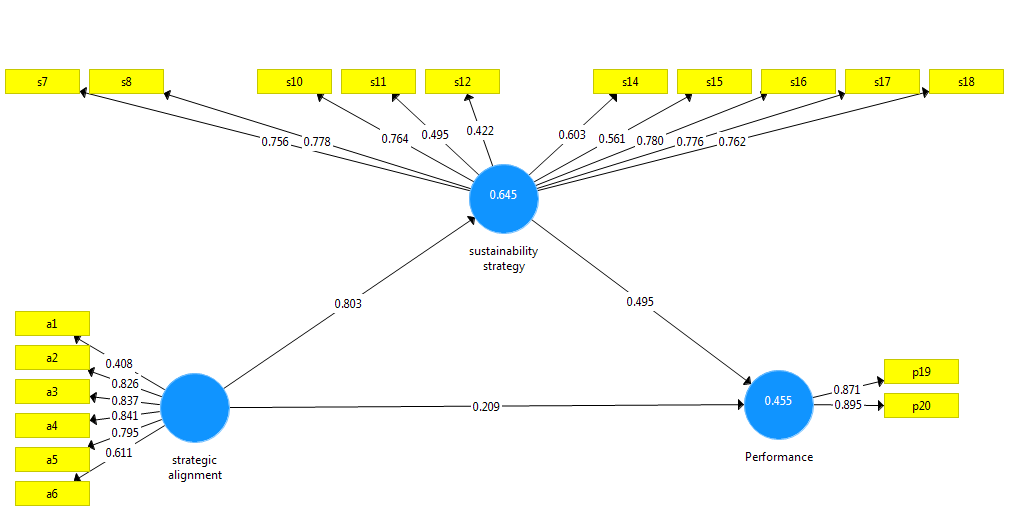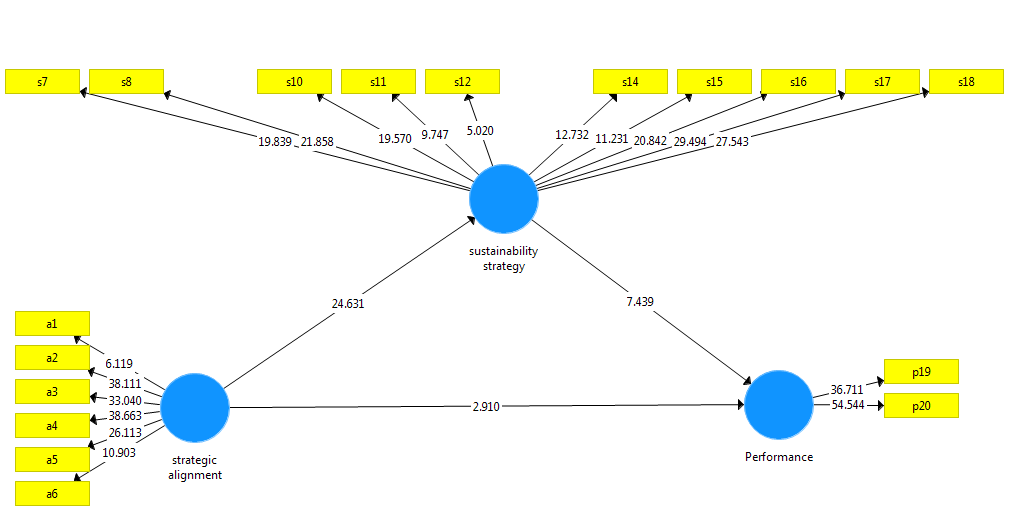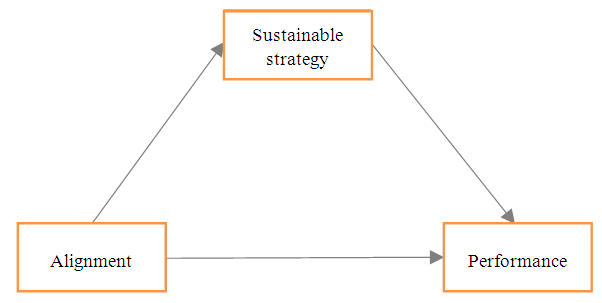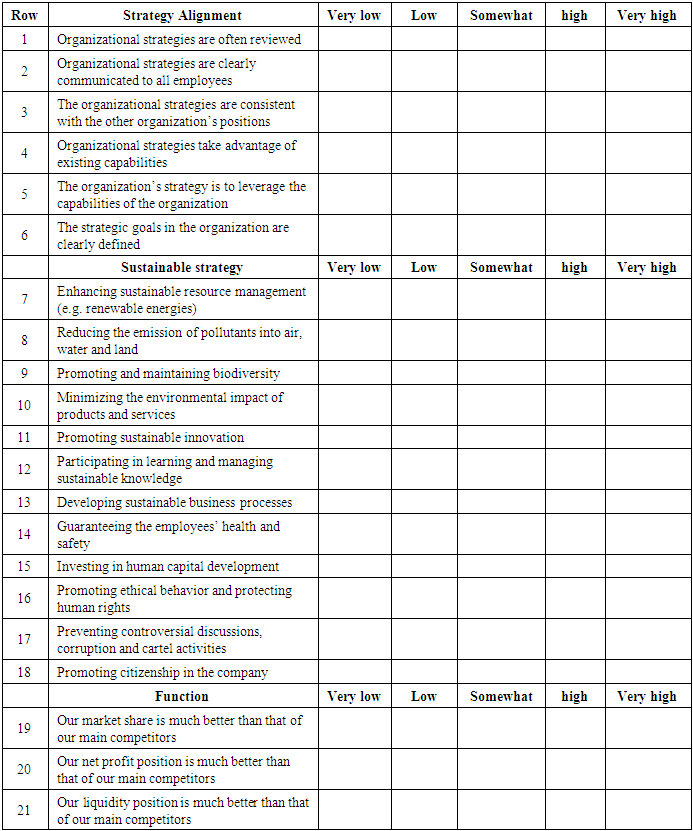-
Paper Information
- Paper Submission
-
Journal Information
- About This Journal
- Editorial Board
- Current Issue
- Archive
- Author Guidelines
- Contact Us
Management
p-ISSN: 2162-9374 e-ISSN: 2162-8416
2020; 10(2): 46-54
doi:10.5923/j.mm.20201002.02
Received: Sep. 3, 2020; Accepted: Sep. 19, 2020; Published: Sep. 26, 2020

Investigating the Impact of Strategic Alignment on Performance Considering the Role of Sustainable Strategy
Nazanin Tourani1, Somayeh Khatibi2
1Department of Business, Faculty of Business, Pennsylvania State University Fayette Campus, Address: Lemont Furnace, PA, USA
2MBA Graduate, Graduate School of Management and Economics, Department of Management, Sharif University of Technology, Tehran, Iran
Correspondence to: Nazanin Tourani, Department of Business, Faculty of Business, Pennsylvania State University Fayette Campus, Address: Lemont Furnace, PA, USA.
| Email: |  |
Copyright © 2020 The Author(s). Published by Scientific & Academic Publishing.
This work is licensed under the Creative Commons Attribution International License (CC BY).
http://creativecommons.org/licenses/by/4.0/

The present study seeks to investigate the impact of strategic alignment on performance considering the role of a sustainable strategy. In this regard, 50 large Iranian food companies were examined and a standard questionnaire with 21 questions was sent to the senior managers of these organizations out of which 240 questionnaires were completely answered and analyzed by structural equations using SmartPLS software. According to the research results, strategy alignment has a positive and significant impact on sustainability strategy and performance. Furthermore, a sustainable strategy has a positive and significant impact on performance.
Keywords: Strategic, Sustainable strategy, Management, PLS
Cite this paper: Nazanin Tourani, Somayeh Khatibi, Investigating the Impact of Strategic Alignment on Performance Considering the Role of Sustainable Strategy, Management, Vol. 10 No. 2, 2020, pp. 46-54. doi: 10.5923/j.mm.20201002.02.
Article Outline
1. Introduction
- The survival of organizations and their systems in today's dynamic, challenging and evolving environment depends on keeping pace with environmental changes, make the right decisions and manage them in a timely manner. On the other hand, the use of appropriate strategies is needed to achieve the proper level of accountability (Deng, et al, 2014). Organizations, with the help of strategy, ensure their success in competition by maximizing profit and effectiveness (Allen & Wright, 2006). As stated in Thompson, Peteraf, Gamble, and Strickland (2012), strategies include competitive movements, business management, employee growth, and development to attract and satisfy consumers and successful competition through operations aimed at achieving organizational goals (Lloret 2016). The new practice approach in strategy literature recommends focusing on real strategic approaches; that is strategy is not something that the company has, but what that it should do (Jarzabkowski, 2004). Increasing competition in today's marketplace has also led senior executives to evaluate and control the key tasks affecting competition and business performance. This is also closely connected to implement and identify best practices within the organization and functional integration across the organization (Sardana et al. 2016). Management is conventionally a top-down activity that uses a cybernetic process of planning and performance measurement to perform the corrective actions that are the core of its strategy. Monitoring strategic alignment, in decentralized settings, refers to observing strategic plans and goals, which is confined to managerial controls such as control of outcomes in the first place. Due to the increasing complexity and constant changes, these approaches have recently gained more support in business (Cäker, M., & Siverbo, 2014). The extent to which plans, strategies, cultures, and other elements of the organization are aligned to achieve a common and defined goal is called alignment (Way & Johnson, 2005). According to studies, the use of advanced technologies will not improve business performance and cannot meet the needs of the market as long as there is no proper strategy (Amoako-Gyampah, K & Acquaah, 2008). According to these studies, there is a need to coordinate production with other functions, particularly marketing (Marques et al., 2014; Paiva, 2010), especially for companies located in emerging countries (Ang et al., 2015). Also, with increasing concern about environmental and social issues and increased stakeholder demand and monitoring, companies are forced to adapt, are under increasing pressure to reduce their impact on the environment and sustain themselves in society by drawing appropriate sustainability strategies (Accenture, 2011).Today, corporate sustainability has become increasingly important to policymakers and decision-makers around the world (UNEP, 2013). As the strategic necessity of the new millennium, the term sustainability refers to organizations that promote long-term economic, social and environmental performance (Galpin et al, 2015). Sustainable strategies are strategies aimed to balance the social, environmental and economic needs of the company and society (Epstein and Roy, 2001). However, some companies still do not have a strategic approach to corporate sustainability (Hahn, 2013). Hence, it is somewhat worrying to integrate corporate sustainability into strategic management. Integrating corporate sustainability into strategic management is a potential approach to address environmental and social challenges and formulating and implementing corporate sustainability strategies (Engert et al, 2016). Although many companies have explored sustainable management and developed sustainability approaches, their main focus in this endeavor is unclear. Usually, it seems that sustainability is more followed than a clear strategy. On the other hand, research has been done to identify and determine the different aspects related to the economic, environmental and social dimensions of sustainability and sustainability reporting guidelines are some common examples in this regard. Strategies should be formulated to work to improve performance on specific issues; however, there is no link between these aspects and strategy sustainability in many cases (Baumgartner & Ebner, 2010). Generally, academic research has made great efforts to examine the strategy implementation subject. According to Li et al. (2008, p. 3), implementing the strategy has become the most important management challenge that all companies currently face (Engert et al, 2016). The volume of literature emphasizing the importance of organizational sustainability and its positive impact on performance is increasing (Galpin et al, 2015). A company must understand how sustainable value is generated through a strategy that meets the organizational goals (Lloret 2016).
2. Theoretical Framework and Hypotheses Formulation
2.1. Strategy Alignment
- The term “strategy” is used for different purposes, although it is defined as a combination of science or art and the use of warfare in planning and monitoring military movements and operations to achieve a specific goal or outcome. The term strategy is derived from the Greek word “strategia” and refers to the ability to formulate a plan to succeed in achieving one or more goals in situations where resources are scarce or uncertain. It was also used as shared mental imagery to help the community design and implement short- and long-term approaches to achieve and transition to sustainable development (Almeida et al, 2015). Porter (1996) shows strategy as the activities of a company that co-ordinates with each other and the theory of competitive advantage (Barney & Hesterly, 2012). Norton (2002) suggests that organizations use strategies to create value for their stakeholders. In other words, an organization's strategy determines how the organization wants to create value for shareholders, customers, and citizens (Kaplan & Norton, 2005). A strategic model can create a firm that is competitive in the long run (Lloret 2016).Five different definitions of strategy are as follows:1) a plan that seriously follows the course of action;2) A misleading gimmick, that is a special maneuver designed to defeat an enemy or competitor;3) A pattern showing the course of action;4) The situation that explains the position of the organization in the environment;5) A perspective that defines a coherent way of looking at the world (Oliver, 2009).Alignment is the extent to which the needs, desires, goals, elements, or structure of one phenomenon are aligned with the needs, desires, goals, elements, or structure of another phenomenon (Carmeli et al, 2010). In other words, alignment is the adjustment of an object in relation to another object (David, 2007). Alignment is a topic that has received much attention at various levels of personal and organizational activity. At the individual level, alignment reflects the alignment of employee activities and behaviors with organizational strategy and activities of other departments and employees (Colvin & Boswell, 2007, Saeedi & Kavian pour 2017). Alignment is the extent of adhesion between two or more organizational dimensions to enhance performance (Nadler & Tushman, 1980). When seeking alignment, a similar effect is visible. Generally, there are several ways to classify alignment. Some scholars have determined that strategy levels as strategic and operational levels (Tarafdar, & Qrunfleh, 2009). Rich and Ben Basat (2000) have also identified dimensions of alignment including rational, structural, social, and cultural (Reich & Benbasat, 2009). Skinner (1974) was the first one who conceptualized the idea of the need for strategic consensus or strategic alignment of competing priorities between different functions of an organization.Since then, strategic operational alignment and marketing performance has been one of the best practices widely proposed to achieve the competitive advantage organizations need in the market (O 'Leary-Kelly & Flores, 2002). In general, strategic alignment in a company will reflect the alignment of operations with company strategy and market requirements (Sardana et al, 2016). Each strategy, in addition to responding to environmental conditions, is consistent with other levels of strategy as well as with the competitive strengths and competencies of the relevant business unit and with the company level as a single set. Each level of strategy interacts closely with other levels of strategy, and if the whole company wants to succeed, it must be integrated into these three levels (Walker et al, 2001). What is important for consistency between different elements of the organization is to achieve a fundamental framework that allows for judgment about the degree of alignment between organizational elements (Fiegenbaum & Thomas, 1988). The key issue for top management is to align the levels of strategy with the organization environment and to coordinate the different organizational components (David, 2007). According to many organizational alignment and composition theories, the effectiveness is high in organizations where the alignment between contextual, structural, and strategic factors is at a high level (Doty et al., 1993). Many theoretical studies and case studies on alignment indicate the importance and competitive advantage that can be obtained by alignment. The concept of alignment is rooted in research on business strategy and considers its starting point in aligning organizational resources with environmental threats and opportunities. On the other hand, the importance of alignment for effective organizational performance is clear today (Delery & Doty, 1996).So it can be said that:There is a positive and significant relationship between strategy alignment and sustainable strategy.There is a positive and significant relationship between strategy alignment and performance.
2.2. Sustainable Strategy
- A business strategy, in the literature, is considered as the driving force of a company (Huang & Qing, 2007). Most organizations use a set of related strategies, each designed at different levels of the company, rather than a comprehensive strategy. The three most important levels of strategy in most large multi-product organizations are 1) Corporate Strategy, 2) Business strategy, and 3) functional strategies focused on a specific product-market (Walker et al, 2001).Corporate sustainability is a strategic and profit-driven response to environmental and social problems caused by the organization's core and sub-activities (Engert et al, 2016). The need for sustainability is clear for society and it is both a responsibility and an opportunity for large companies. It is our responsibility to act ethically and to ensure that products and operations are safe for humans and the environment so that if this is integrated into the business, there is an opportunity to meet new consumer needs, create superior jobs, reduce costs, create a spirit of empowerment for employees and provide value to the community and stakeholders in general (White, 2009). Corporate sustainability is based on the concept of sustainable development that is defined as development that meets the needs of the present without compromising the ability of future generations to meet their needs (Engert et al, 2016).According to England's state definition (Hosseinpour, 2018 & DETR, 1999), sustainability is the guarantee of a better quality of life now and for future generations, which includes environmental, social responsibility and economic development that can vary (Basirat et al 2018 & White, 2009). Sustainable development is the result of growing awareness at global levels of environmental, social, economic, poverty and inequality issues and concerns about a healthy future for mankind. Sustainable development closely links these issues (environmental, social and economic) (Hopwood et al. 2005). Sustainable development in general terms means balancing development with the environment. In other words, sustainable development meets the needs of today's generation without compromising the ability of future generations to meet their needs (Banihabib et al, 2019). According to Salzmann et al. (2005), corporate sustainability strategies may not be appropriate for all companies at all times. The conditions are significantly different (for example in terms of industry, product type or service, stakeholder demands, policies, market changes, internal structure, and processes, etc.), so choosing a sustainable strategy is very challenging (Baumgartner, 2014). Practically, corporate sustainable strategies must be carefully adjusted to meet specific company requirements (Ahmadzadegan et al, 2013 & Engert et al, 2016).In the early 1990s, although the Earth Summit was heavily on the agenda, by the end of the decade, the Millennium Development Goals were set in motion, and the World Summit on Sustainable Development in Johannesburg focused more on poverty reduction, development and social pillars (White, 2009). On the other hand, research has been done to identify and determine sustainability aspects of specific dimensions in the economic, environmental and social contexts. Economic and environmental dimensions are often discussed as general dimensions of corporate sustainability. Using such general aspects seems to be significant because good results in these aspects lead to good financial results and the sustainability of the company. Economic sustainability includes the general aspects of an organization that must be respected in order to stay in the market for the long term alongside the environmental and social aspects (Baumgartner & Ebner, 2010). The resource-based view shows that internal resources and scarce capabilities are valuable and undeniable in creating sustainable competitive advantage. Considering the disadvantages and limitations of the resource-based view, Hart (1995) has suggested the natural resources view that it expresses the capabilities that lead to a competitive advantage when companies interact with their natural environment. Hart (1995, p. 991) emphasized that strategy and competitive advantage may lie in capabilities that facilitate sustainable environmental economic activities based on a natural resource perspective in the coming years (Ahmadzadegan et al 2014 & Wijethilake, 2017). The natural resource-based view proposes three interconnected strategies that lead to sustainable competition: pollution prevention, monitoring product and sustainable development (Wijethilake, 2017). Therefore, management needs to consider these aspects rather than focusing on the financial aspects that only show the financial results to achieve economic success. The use of such public aspects affects the company's environmental activities. These environmental impacts are caused by the use of resources and emissions into the air, water, and land, as well as hazardous waste. Furthermore, the impact of biodiversity and environmental issues throughout the product life cycle is important. This dimension is usually measured by the effects. However, the focus on sustainable company strategies is on the factors that influence these effects (Baumgartner & Ebner, 2010). Social sustainability is a set of measures and policies aimed at improving the life quality and equitable access to the distribution of rights and benefits and appropriate allocation of the natural and artificial environment. This implies improving local living conditions by reducing poverty and increasing satisfaction with basic social sustainability needs (Pacion, 2009). Social Sustainability is defined as healthy, fertile, and environmentally friendly living (GTZ Project Office, 2004) Murphy, in his definitions of social sustainability, refers to four main pillars of justice, participation, awareness of social sustainability and solidarity (Murphy, 2012). On the other hand, social sustainability is the quality of societies and the nature of social relationships and somehow reflects the internal relationships of society (Littig and Griessler, 2005). So it can be said that:The sustainable strategy has a positive and significant impact on performance.
2.3. Performance
- Organizational performance has been defined as the degree of efficiency, effectiveness and synergy of business strategies in recent years (Olson et al, 2005).The Oxford Dictionary defines the performance as performing a whole task and evaluate the process of researching, evaluating, and evaluating the quality, value, and nature of that task (Lawrence et al 2019 & Herried, 2006).Specifically, two types of performance evaluation can be distinguished in the literature, financial performance or measuring objectives such as return on assets, return on investment, etc., and non-financial performance or measurement of indicators such as shareholder satisfaction, employee and customer satisfaction (Nagahi et al 2018 & Ouakouak et al., 2014).
2.4. Research Conceptual Model
3. Research Methodology
3.1. Samples and Data Collection
- Fifty large Iranian food industry companies were selected for the purpose of the present study, that the researcher contacted them and made the necessary arrangements to collect the questionnaire, given that people needed complete information from the organization to answer questions. Top executives were selected as the statistical population, including 270 senior managers of these 50 companies; then, questionnaires were sent by email to the aforementioned companies and corporate executives responded to the questionnaires. After the questionnaires were distributed and collected electronically, 240 questionnaires were completed that were used for analysis.
3.2. Measurement
- As mentioned above, this research has conducted a managerial evaluation. Therefore, they were selected as the statistical population to measure the structures and to answer the questionnaires of managers of organizations. Standard questionnaires were used to measure structures, questionnaire for measuring strategy alignment variable (Sardana et al, 2016), questionnaire for sustainable strategy variable (Wijethilake, 2017), and questionnaire for performance variable (Al -Surmi, et al., 2019), which is described in the appendix. A five-point Likert scale was used to answer the questionnaire and respondents were asked to rate their agreement with each item.
4. Results
- The partial least squares method and PLS software were used to analyze the research data, which are described in two steps:Step one: the measurement model fit: for this step, after obtaining the factor loadings and the T statistic (visible in Figures 1, 2, 3 and 4), convergent validity and reliability criteria were used.The factor loadings for each question should be above 0.4 and the T statistic should be outside the positive and negative range of 1.96, so questions that do not meet these requirements will be excluded from the model. As can be seen, questions 9, 13 and 21 are omitted. The partial least squares method uses the Average variance Extracted (AVE) to calculate the construct convergent validity. The minimum value for validity is 0.5 for each construct. Cronbach's alpha and hybrid reliability were used to obtain reliability, which 0.7 and 0.5 are respectively needed to confirm each criterion. The results of these tests can be seen in Table 2:
|
|
 | Figure 2. The research conceptual model in coefficient estimation mode |
 | Figure 3. The research conceptual model in semantic coefficients (T statistic) |
 | Figure 4. The research corrective conceptual model in coefficient estimation mode |
 | Figure 5. The research conceptual model in corrective mode of coefficients significance (T-statistic) |
|
5. Discussion and Conclusions
- The present study was conducted to investigate the effect of strategic alignment on performance considering the role of a sustainable strategy. In this regard, four hypotheses were investigated in this study, which is based on the results obtained from the analysis of information on the first and second hypotheses. Strategy alignment has a positive and significant impact on sustainability strategy and performance, so improving strategy alignment can improve sustainable strategy because an organization's strategy determines how the organization wants to create value for shareholders, customers and citizens (Kaplan & Norton, 2005) and as many theories of alignment and organization configuration shows, in organizations where there is high level of alignment between contextual, structural, and strategic factors, their effectiveness is high (Doty et al., 1993). So it can be said that strategy alignment can affect sustainable strategy and performance in this way. Also, according to the third hypothesis, the sustainable strategy has a positive and significant impact on performance; sustainable strategy is rooted in sustainable development; sustainable development is the result of growing awareness at a global level about environmental, social, economic, poverty and inequality issues and concerns about a healthy future for mankind. Sustainable development tightly links these subjects (environmental, social and economic) (Hopwood et al. 2005), which can affect performance in the long run. According to the fourth hypothesis and the results of the Seville test, sustainable strategy played a mediating role in the relationship between strategic alignment and performance. Accordingly, it can be said that in practice, the firm's sustainable strategies to meet the specific requirements of the company need to be carefully adjusted (Engert et al, 2016). Economic and environmental dimensions are often discussed as general dimensions of corporate sustainability. Using such general aspects seems to be significant because good results in these aspects lead to good financial results and firm sustainability (Baumgartner & Ebner, 2010).
6. Research Limitations and Future Suggestions
- Any research can have some limitations in its procedure. This research is not an exception and has some limitations including the statistical population as well as the use of the questionnaire as a measurement tool because no observation or interviewing was used in this study. Therefore, given the limitations available to future researchers, it may be suggested to examine this research in different statistical societies and in other industries. Other statistical methods can also be used in post-mortem research and observation and interviewing tools.QuestionnaireHow do you evaluate each of the following items in your organization?
|
 Abstract
Abstract Reference
Reference Full-Text PDF
Full-Text PDF Full-text HTML
Full-text HTML



